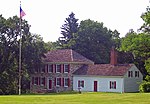Haskell House (New Windsor, New York)
Historic American Buildings Survey in New York (state)Houses on the National Register of Historic Places in New York (state)National Register of Historic Places in Orange County, New York

The John Haskell House, also known as the Hermitage, was a historic home located in New Windsor, Orange County, New York. It was built about 1726, and was a 2+1⁄2-story log dwelling with a rear ell. It had a gabled roof and large interior chimney at each end. Due to its construction, the Haskell House was considered one of the largest intact log mansions in the Thirteen Colonies.
Excerpt from the Wikipedia article Haskell House (New Windsor, New York) (License: CC BY-SA 3.0, Authors, Images).Haskell House (New Windsor, New York)
Windsor Highway,
Geographical coordinates (GPS) Address Nearby Places Show on map
Geographical coordinates (GPS)
| Latitude | Longitude |
|---|---|
| N 41.480555555556 ° | E -74.0425 ° |
Address
Windsor Highway 154
12553
New York, United States
Open on Google Maps








